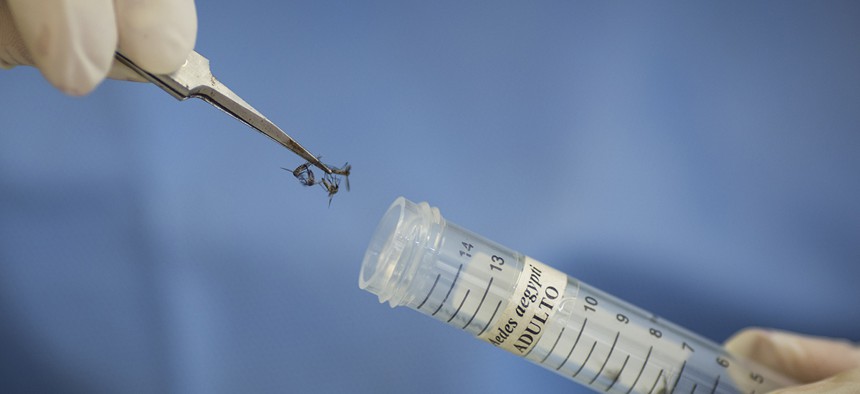The Innovative Suitcase Lab That Could Fight the Zika Virus

A technician of the Fiocruz institue stores Aedes aegypti mosquitoes to be used in research, in Recife, Pernambuco state, Brazil, Wednesday, Jan. 27, 2016. Felipe Dana/AP
The whole thing weighs less than 44 pounds and is operated with a laptop.
The World Health Organization has declared Zika a global health emergency, because it believes the risks are high enough for a global response. And yet, we understand little about the virus and its effects on people. Zika’s links to neurological conditions, such as microcephaly—abnormal brain development in newborns—remain unproven.
A team of Brazilian and African scientists (link in Portuguese) believe rapid and thorough testing for Zika will be key to solving that mystery. Given Brazil’s vast size and limited infrastructure, though, they’re having to deploy an inventive diagnostic tool to achieve that: A suitcase-sized laboratory.
Since the beginning of the year, researchers from the Institute of Biomedical Sciences of São Paulo University and the Pasteur Institute of Dakar, Senegal have been working to adapt mobile-laboratory technology, which was used in Africa to detect Ebola, to analyze Brazil’s Zika epidemic.
The whole thing weighs less than 20 kgs (44 pounds) and is operated with a laptop. The components used to test samples, which would have to be kept frozen in a traditional lab setting, are all in powder form, not unlike a boxed cake mix that only requires water.
The mobile lab will start testing patients’ saliva, blood and urine in the northeastern state of Sergipe, where dozens of microcephaly cases (Portuguese) have been reported, in mid-February. The test results will be available within 30 minutes, instead of the many hours or even days that commonly used techniques require.
In West Africa, a portable gene-sequencing device called MinION helped researchers map the spread of Ebola by linking the lineages of cases in Guinea and Sierra Leone. (The research has just been published in Nature.) The mobile lab in Brazil doesn’t do gene-sequencing—the MinION is too expensive, Daniel Ferreira, one of the researchers on the project, told Quartz. But it will still make disease-mapping easier and quicker, by identifying Zika samples that can then be sent to be sequenced at a full-fledged lab.
“Our goal is to understand what’s happening in remote areas of Brazil and actually interfere with the process,” Ferreira said.
Zika presents its own particular challenges, though. While not as deadly as Ebola, it’s harder to track, because many people who get infected never show symptoms. Those people won’t seek medical help, says Arthur Reingold, head of epidemiology at University of California, Berkeley, making it harder to collect information. “It’s just the tip of the iceberg that you can possibly identify,” he tells Quartz.
Zika is also hard to test for. Many tests based on blood serum can’t distinguish Zika conclusively from other mosquito-borne viruses in the same area, such as yellow fever or West Nile, says Nikos Vasilakis of University of Texas Medical Branch, who is working to develop better ways of identifying Zika.
“Basically, you can get false positives all the time,” he tells Quartz.
The other testing technique, which looks for the virus’s genetic signature, is complicated as well. To identify a virus by its genes, scientists need recent samples of it for comparison (since viruses mutate). But Zika is hard to isolate from infected patients’ serum samples, so there aren’t many publicly available gene sequences from the current pandemic.
Still, Ferreira believes mobile testing can help scientists understand and corral the disease. Rapidly identifying Zika flare-ups can help better target mosquito spraying, and the test data can offer clues about how the virus is evolving and proliferating.





